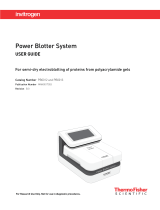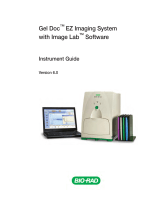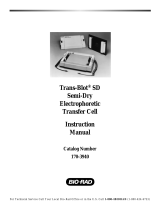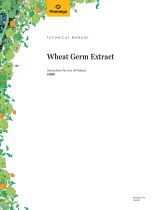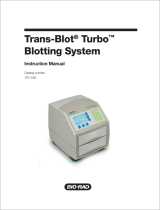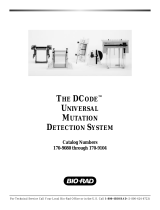
SimplyBlue™ SafeStain
Rapid, sensitive, and safe Coomassie™ G-250 stain for protein visualization
Catalog Numbers LC6060 and LC6065
Pub. No. MAN0000735 Rev. 4.0
WARNING! Read the Safety Data Sheets (SDSs) and follow the handling instructions. Wear appropriate protective eyewear,
clothing, and gloves. Safety Data Sheets (SDSs) are available from thermosher.com/support.
Product description
Invitrogen™ SimplyBlue™ SafeStain is a ready-to-use, proprietary Coomassie™ G-250 stain that is specially-formulated for rapid, sensitive
detection, and safe, non-hazardous disposal. This stain does not require the use of methanol or acetic acid, thus eliminating the need to
dispose of hazardous waste. SimplyBlue™ SafeStain has been tested for environmental hazards (see “Summary of environmental
testing“ on page 4).
Proteins stained using SimplyBlue™ SafeStain are compatible with mass spectrometry (MS) analysis.
Contents and storage
Cat. No. Amount Storage[1]
LC6060 1 L[2] 15°C to 30°C
Keep the bottle capped when not in use.
LC6065 3.5 L[3]
[1] See the product label for expiration date.
[2] Sufficient to stain 50 mini-gels.
[3] Sufficient to stain 175 mini-gels.
Recommended staining protocols
• The Basic protocol is recommended for use with 1.0-mm and 1.5-mm Tris-Glycine gels, 1.0-mm NuPAGE™ Novex™ Gels, and 1.0-mm
Tricine mini-gels (8 × 8 cm) (see “Stain gels: Basic protocol“ on page 2). To achieve maximum sensitivity, see “Stain gels: Maximum
sensitivity protocol“ on page 2.
• For large-format gels, follow the Basic protocol for staining, adjusting the volumes of water and stain as described (see “Large-format
gels: Recommended water and stain volumes“ on page 3).
• The Microwave protocol can be performed in approximately 12 minutes and yields results with sensitivity as low as 5 ng (see “Stain
gels: Microwave protocol“ on page 2).
• To stain IEF Gels, 1.5-mm NuPAGE™ Novex™ Gels, Zymogram gels, or PVDF membranes, see “Stain gels: IEF Gels, 1.5-mm NuPAGE™
Novex™ Gels, Zymogram gels, or PVDF membranes“ on page 3.
Procedural guidelines
•IMPORTANT! An alcohol/acetic acid xing step is NOT required or recommended before staining.
• SimplyBlue™ SafeStain is not recommended for staining nitrocellulose or wet PVDF membranes.
• Ensure the gel moves freely in water or stain to facilitate diusion during all steps.
• Do not reuse SimplyBlue™ SafeStain.
USER GUIDE
For Research Use Only. Not for use in diagnostic procedures.

Methods
Stain gels: Basic protocol
To achieve maximum sensitivity, see “Stain gels: Maximum sensitivity protocol“ on page 2.
For large-format gels, see “Large-format gels: Recommended water and stain volumes“ on page 3.
1. After electrophoresis, rinse the mini-gel 3 times for 5 minutes with 100 mL deionized water to remove SDS and buer salts, which
interfere with binding of the dye to the protein. Discard each rinse.
2. Add a sucient volume of SimplyBlue™ SafeStain (∼20 mL) to cover the mini-gel, then incubate for 1 hour at room temperature with
gentle shaking. Bands begin to develop within minutes. After incubation, discard the stain.
Note: The gel can be stained for up to 3 hours, but after 3 hours, sensitivity decreases. If you need to leave the gel overnight in the
stain, add 2 mL of 20% NaCl (w/v) in water for every 20 mL of stain. This procedure will not aect sensitivity.
3. Wash the mini-gel with 100 mL of water for 1–3 hours.
Note: The gel can be left in the water for several days without loss of sensitivity. There is a small amount of dye in the water that is in
equilibrium with the dye bound to the protein, so proteins remain blue.
4. To obtain the clearest background for photography, perform a second 1-hour wash with 100 mL of water.
Note: Sensitivity decreases if the gel is stored in water for more than 1 day. The decrease in the amount of free dye in the water
favors dissociation of the dye from the protein. If you need to store the gel in water for a few days, add 20 mL of 20% NaCl.
Stain gels: Maximum sensitivity protocol
The addition of salt in the following procedure results in a signicant improvement in sensitivity. The values provided are for 1.0-mm
mini-gels. For 1.5-mm mini-gels, use the values in parentheses.
Note: Sensitivity is primarily a function of the dye-protein interaction, which is unique for each protein.
1. Prepare a 20% NaCl (w/v) solution in deionized water, enough to add 20 mL (30 mL) per gel.
2. Perform step 1 and step 2 of the Basic protocol (see “Stain gels: Basic protocol“ on page 2).
3. After staining the gel, wash the gel with 100 mL (150 mL) of water for 1 hour.
4. Add 20 mL (30 mL) of 20% NaCl to the water in step 3, then continue to wash for an additional 2 hours or overnight (if desired).
Stain gels: Microwave protocol
This procedure requires an additional incubation with a salt solution. The values provided are for 1.0-mm mini-gels. For 1.5-mm mini-gels,
use the values in parentheses.
IMPORTANT! Use caution when heating the stain in a microwave oven. Do not overheat the staining solution.
1. After electrophoresis, place the gel in 100 mL of ultrapure water in a loosely-covered container, then microwave at high power (950 to
1,100 was) for 1 minute or until the solution almost boils.
2. Agitate the gel on an orbital shaker for 1 minute (2 minutes), then discard the water.
3. Repeat step 1 and step 2 of this procedure 2 additional times.
4. After the last wash, add 20 mL (30 mL) of SimplyBlue™ SafeStain, then microwave at high power for 45 seconds to 1 minute
(1.5 minutes) or until the solution almost boils.
5. Agitate the gel on an orbital shaker for 5 minutes (10 minutes). (Detection limit: 20 ng BSA.)
6. Wash the gel in 100 mL of ultrapure water for 10 minutes on a shaker. (Detection limit: 10 ng BSA.)
7. Add 20 mL of 20% NaCl, then incubate for a minimum of 5 minutes. (Detection limit: 5 ng BSA.)
The gel can be stored in the salt solution for several weeks.
2
SimplyBlue
™
SafeStain User Guide

Stain gels: IEF Gels, 1.5-mm NuPAGE™ Novex™ Gels, Zymogram gels, or PVDF membranes
Stain Zymogram gels after renaturing and developing the gel for enzyme activity.
Stain IEF Gels, 1.5-mm NuPAGE™ Novex™ Gels, and polyvinylidine diuoride (PVDF) membranes using the Basic protocol with the
following modications.
Gel or Membrane Fix Rinse Stain Wash
IEF gels 100 mL of 12% TCA for
15 minutes
Basic protocol, step 1 on
page 2 100 mL of stain for 1 hour Basic protocol, step 3 on
page 2
1.5-mm NuPAGE™ gels N/A
150 mL of water
2 × 5 minutes
1 × 10 minutes
Basic protocol, step 2 on
page 2
Basic protocol, step 3 on
page 2
Dry PVDF membrane N/A N/A 10–20 mL of stain for
1–2 minutes[1]
10–20 mL of water
3 × 1 minute
Zymogram gels N/A Basic protocol, step 1 on
page 2 100 mL of stain for 1 hour Basic protocol, step 3 on
page 2
[1] Incubating dry PVDF membranes in stain for >2 minutes results in high background.
Large-format gels: Recommended water and stain volumes
For large-format gels, follow the Basic protocol for staining, adjusting the volumes of water and stain as indicated in the following table.
Gel size Water volume[1] Stain volume
15 × 15 cm, 1 mm 300 mL 60 mL
15 × 15 cm, 1.5 mm 500 mL 100 mL
20 × 20 cm, 1 mm 600 mL 120 mL
[1] Recommended for each rinse and wash step.
Dry the gel
Incubating any Coomassie™-stained gel in an alcohol solution will eventually result in destaining of the bands. If you use Gel-Dry™ Drying
Solution, incubate the gel in the solution for no longer than 5 minutes.
Destain protein bands for MS analysis
Use the following general guidelines to destain protein bands prior to MS analysis. Contact your MS facility or the protein core facility for
detailed protocols.
1. Excise the protein band of interest from the gel using a clean scalpel, then destain with 10–30% ethanol or 20–30% acetonitrile for
10–15 minutes or until the gel piece is clear.
2. Rinse the gel piece in ultrapure water, then proceed to MS analysis.
SimplyBlue
™
SafeStain User Guide
3

Supplemental information
Summary of environmental testing
SimplyBlue™ SafeStain has been tested by an independent and certied laboratory for environmental hazards. The results are summarized
in the following table.
Analysis Method Results
Ignitability EPA 1010 Non-flammable (>144℉)
Corrosivity EPA 150.1 Non-corrosive (pH ≥2.1)
Corrosivity (by Corrositex™ test) DOT-E 10904 Non-corrosive
Reactivity (cyanide and sulfide)
• EPA 9010B/9014
• EPA 9030A No reactivity detected
Aquatic toxicity (fathead minnow; definitive, CAC, Title 22) CA Fish and Game Non-toxic
Limited product warranty
Life Technologies Corporation and/or its aliate(s) warrant their products as set forth in the Life Technologies' General Terms and
Conditions of Sale at www.thermosher.com/us/en/home/global/terms-and-conditions.html. If you have any questions, please contact
Life Technologies at www.thermosher.com/support.
Life Technologies Corporation | 5781 Van Allen Way | Carlsbad, CA 92008
For descriptions of symbols on product labels or product documents, go to thermofisher.com/symbols-definition.
The information in this guide is subject to change without notice.
DISCLAIMER: TO THE EXTENT ALLOWED BY LAW, THERMO FISHER SCIENTIFIC INC. AND/OR ITS AFFILIATE(S) WILL NOT BE LIABLE FOR SPECIAL, INCIDENTAL, INDIRECT,
PUNITIVE, MULTIPLE, OR CONSEQUENTIAL DAMAGES IN CONNECTION WITH OR ARISING FROM THIS DOCUMENT, INCLUDING YOUR USE OF IT.
Revision history: Pub. No. MAN0000735
Revision Date Description
4.0 17 January 2020
• Updated to the current document template, with associated updates to the warranty, trademarks, and logos.
• Updated the storage guidelines.
3.0 13 February 2012 Baseline for this revision history.
Important Licensing Information: These products may be covered by one or more Limited Use Label Licenses. By use of these products, you accept the terms and conditions of all
applicable Limited Use Label Licenses.
©2020 Thermo Fisher Scientific Inc. All rights reserved. All trademarks are the property of Thermo Fisher Scientific and its subsidiaries unless otherwise specified. Corrositex is a
trademark of In Vitro International, Inc.
thermofisher.com/support | thermofisher.com/askaquestion
thermofisher.com
17 January 2020
/







